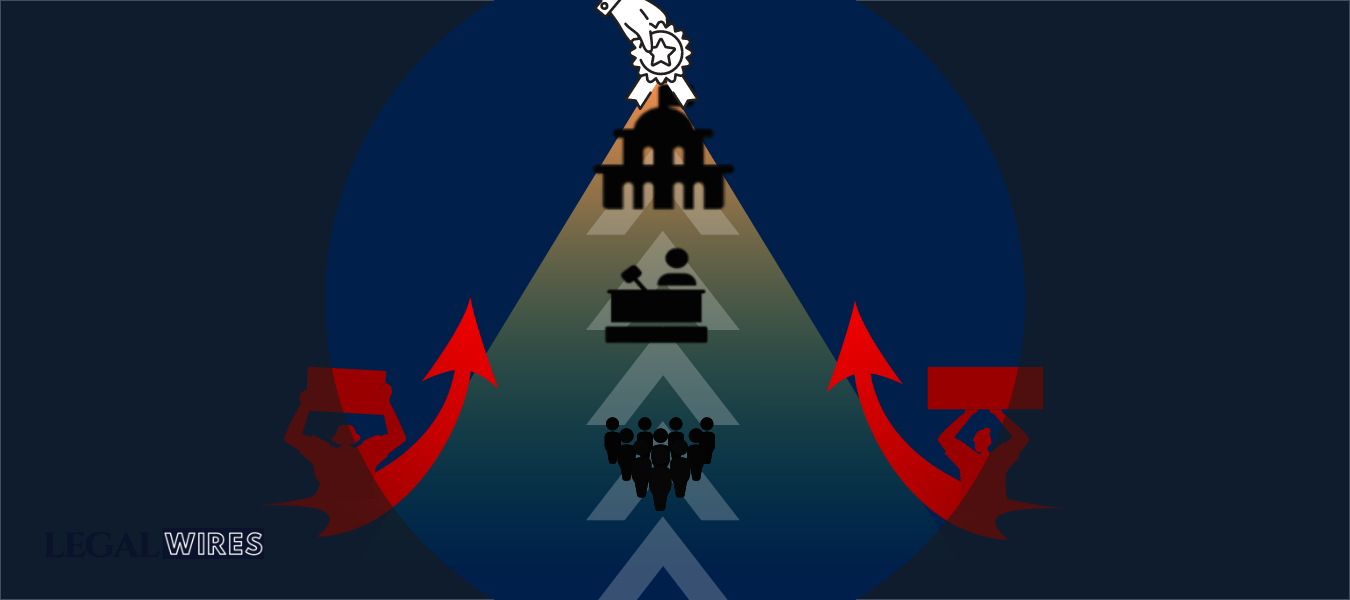India, being one of the greatest nations in the world with a huge population, has a powerful judiciary arrangement that is integrated with the structure of the courts and its hierarchy and the judicial conformity.

Introduction
India, being one of the greatest nations in the world with a huge population, has a powerful judiciary arrangement that is integrated with the structure of the courts and its hierarchy and the judicial conformity. This arrangement presents resources to a huge number of specialists connected to the practice of the judiciary in various applications and thus helps the nation with assistance. In this article, the fundamental design of the judiciary system will be described with the hierarchical type of courts that definitely take part in the judiciary arrangement and the different characters involved in this declaration to play distinct functions entrusted to them. Because of the dimension of the nation, the judiciary system is designed as per the terms of the citizens of India with the situation of courts as per situation to assist the inhabitants of India with energy. India has a rich culture of administering justice to the afflicted and the courts at different levels are there to help the idea of continuing the highest level of the effective juridical system all over the nation[1]. The court building is set as per the judiciary system commanding in India with differentiation of applicability as per the benefit of the case. The natural trend of the judiciary system is to begin any usual argument in the lower court, which is being increased as per the comfort of the contractors to the more powerful courts. The hierarchical arrangement of the court is being supported by the Constituency of India with the level of influence exerted by the various levels of courts. The decisions can be claimed in the higher courts if the parties to the cases are not convinced. The means of growth is well-organized, and thus the system of presenting the highest level of comfort to the parties is seriously contested by the judiciary system.
In this present article, we will highlight the features of the judiciary system in India –
Hierarchy of courts in India
The feature Indian judiciary system is its hierarchical arrangement of courts. There are various levels of the judiciary practice in India approved with different types of courts. The courts are structured with a very effective judiciary and the hierarchical arrangement as per the powers presented upon them. This system is powerful, sufficient to create boundaries of court with its jurisdiction and operation of the power. The Supreme Court of India is located at the top of the hierarchical position supported by High Courts in the provincial level & lower courts at the micro-level with the distribution of power and exercising of the equivalent for the people of India[2].
Supreme Court of India
Supreme Court of India is the most powerful level of the court of Indian juridical system which was installed as per Part V, Chapter IV of the Constitution of India which guarantees the thought of Supreme Court as the Federal Court to perform the function of the superintendent of the esteemed constitution of India with the rank of the most important level of court in the situation of appeal cases[3].
Constitution Regulation
As discussed by Articles 124 to 147 of Indian Constitution, the jurisdiction, and production of the Supreme Court are being established. This court is essentially the status of the appellate court. This court is allowing the appeals of cases that are being detected in the High courts established in different states and union territories with the disappointment with similar parties. This court also believes writ petitions with the presumed existence of exercises that may indicate about the infringement of human rights and consequent petitions are allowed to hear and judge the results of such incidents.
These types of appeals are allowed under Article 32 of the Indian constitution. This article discusses the right to guarantee remedies through the constitution. This court also understands about such grave problems that need to be served with critical consideration [4].
- High Court of India
- Constitution
High Courts are following Courts of Consequence of the democracy of India. They are governed by Article 141 of the Constitution of India. They are administered by the junctions presented by the Supreme Court of India, so far decisions and regulations are concerned. The Supreme Court of India is the most powerful level of courts and is accountable for making the administration to the High Court’s set by priority.
High courts are the kinds of courts that are established as the courts powered by the constitution with the effect of Article 214 Part IV Chapter V of the Indian Constitution. There are 24 high courts in India practising the application of the regional juridical system of India out of which Kolkata High Court is the oldest[5].
Jurisdiction
These courts are essentially restricted to the jurisdiction of the state, organization of states, or Union Territory. They are being permitted to administer the jurisdiction of lower courts like family, civil, and criminal courts with other various courts of the districts. These courts are of the statute of important civil courts so far innovation of jurisdiction is involved in the relevant field of the states and the other community courts.
These courts are employed as secondary to High Courts by status. But High Courts are essentially operating their jurisdiction compared to the civil or criminal region if the lower courts are proved ineffective of exercising their power as per permission reached by law. These positions may be created through the failure of financial or territorial jurisdiction. There are special areas in which only High Courts can execute the right for learning like cases related to Company Law as it is assigned, especially in a state or federal law.
But frequently the high courts are included in the appeals established in the cases of lower courts with the writ petitions as presented in Article 226 of the Constitution of India. The area of writ appeals is also the sole discretion of high courts. The jurisdiction of the High Court is changing so far national jurisdiction is considered[6].
- Lower Courts of India
- District Courts
- Constitution
The support of the structuring of district courts in India largely depends upon the choice of the state governments or the union territories. The constructions of those courts are essentially made regarding various circumstances like the number of cases, number of population, etc. Depending upon those circumstances the state administration takes the determination of numbers of District Courts to be in maintenance for the single district or beating together several neighbouring districts. Normally these kinds of courts handle their power of juridical service at the district level. These courts are reported by the executive power of the High Court’s under which the district courts are surfaced. The decisions of the district courts are subjected to revision to the appellate jurisdiction of the several high courts [7].
Structure and Jurisdiction
The district courts are largely run by the state government designated district judges. There are additional district judges and assistant district judges who are there to bestow the extra weight of the procedures of District Courts. These new district judges have similar capabilities like the district judges for the administration area of any city which has got the rank of the metropolitan area as presented by the state government. These district courts have the supplementary jurisdictional authorization of appeal treatment over the lower courts, which are there in the same district, especially in the field of civil and criminal cases. The subordinate courts including the civil cases, in this regard, are recognized as Junior Civil Judge Court, Principal Junior, and Senior Civil Judge Court, which are also identified as Sub Courts, Subordinate Courts. All these courts are used with rising orders. The subordinate courts including the criminal cases are Second Class Judicial Magistrate Court, First Class Judicial Magistrate Court, and Chief Judicial Magistrate Court forward with family courts which are established to dispense with the problems associated with conflicts of marital problems only. The status of the Supreme Judge of the family court is at par with the District Judge [8]. There are in total 351 district courts in operation out of which 342 are of states while nine are of union territories.
[1] Alok Prasanna Kumar, 2016, How many judges does India really need?
[2] Ssrana, 2015, Indian Court Structure
[3] Gktoday, 2016, Supreme Court of India
[4] Clearias, 2014The Union Judiciary ie. The Supreme Court (Articles 124-147)
[5] Indianetzone, 2013, High Courts in India
[6] Ipleaders, 2014, What is Jurisdiction?
[7] Nic, 2016, District Courts
[8] Ecourts, 2015, District Courts of India


